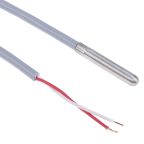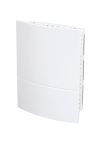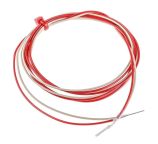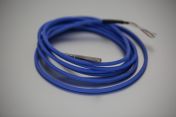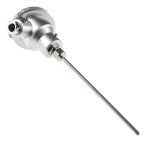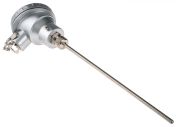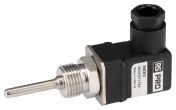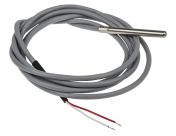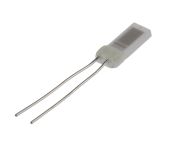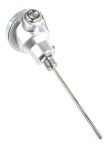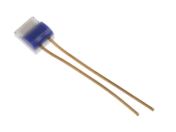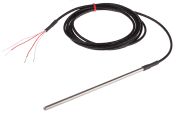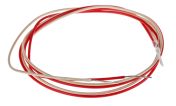RTD Sensors
Resistance temperature detectors (RTD)are used to sense varying temperature ranges and levels of resistance in industrial and commercial applications. An RTD temp sensor consists of a resistance element and insulated copper wires.
The resistive device is usually made of platinum, nickel, nickel-iron or copper, as these materials have high accuracy, fast response time and a wide temperature range. The main function of an RTD is to probe increases and decreases in temperature and control them accordingly.
How do RTD Sensors Work?
RTDs use a metal sensor to detect changes in temperature. This sensor is placed where the temperature measurement needs to occur. When an electrical current passes through the metal sensor, its resistance changes. As the temperature increases, the RTD’s electrical resistance increases, which is measured in ohms.
The resistance value can be converted into temperature and the resistance ratio can vary based on the element used for the resistor. The flow of electricity is then decreased, subsequently reducing the temperature.
Types of RTD Sensors
RTD circuits are configured to accurately measure the sensor's resistance. However, lead wires connecting the resistance element to the measuring element introduce their own resistance, potentially causing errors.
To address this, two-, three-, and four-wire sensors are employed, providing a means of compensating for these errors in temperature and resistance measurement. Some of the more common sensors include:
Pt100 Sensor
The most common type of RTD is a Pt100. Pt100 sensors, characterised by their 100-ohm resistance at 0°C, are known for their high levels of accuracy, stability and repeatability. They are commonly used to measure temperatures ranging from -200°C to 850°C. This accuracy and adherence to the IEC 60751 standard make the Pt100 a laboratory-grade sensor.
**
Pt1000 Sensor**
Pt1000's, while less common, are also available and share similar temperature ranges and tolerances with Pt100 sensors. The key distinction lies in their resistance value — a Pt1000 will have a resistance reading ten times higher than the Pt100 at the same temperature.
This higher resistance makes them less susceptible to errors caused by lead wire resistance, particularly in applications with long cable runs or noisy environments. Like Pt100 sensors, Pt1000 sensors can also utilise two-, three-, and four-wire configurations to enhance measurement accuracy.
Benefits of Using RS RTD Sensors
Harnessing the power of resistance to deliver precise temperature readings, RS’ RTD sensors offer a myriad of advantages:
- Accurate Temperature Measurement: RS’ RTD sensors deliver exceptional accuracy, crucial for industries where even slight temperature shifts impact quality.
- **High Temperature Ranges: **Unlike many sensors, they are able to handle extreme heat, ensuring reliable performance in demanding industrial environments.
- Improved Durability: Built with robust materials, RS’ RTD sensors resist corrosion and vibration, offering a longer lifespan and reduced maintenance.
- Consistency: RS’ RTD sensors maintain their accuracy and stability over time, vital for process control and product quality.
- Repeatability and Reliability: Even with repeated temperature cycles, RS’ RTD sensors deliver precise measurements, fostering confidence in performance.
RTDs vs Thermocouples
While both RTDs and thermocouples serve as temperature sensors, with applications even extending to devices like a thermostat switch, RTD sensors distinguish themselves with several advantages, making them the preferred choice in many industrial and scientific applications demanding precision and stability.
- Wider Temperature Range: Compared to thermocouples, RTDs offer a significantly broader temperature measurement range, capable of handling both frigid and scorching conditions, making them adaptable across various industrial applications.
- **Unmatched Accuracy: **When precision is paramount, RTDs reign supreme, providing exceptionally accurate temperature readings compared to thermocouples. This high degree of accuracy is vital in industries where even minor temperature fluctuations can have significant consequences.
- Effortless Interchangeability: RTDs boast superior interchangeability compared to thermocouples, meaning replacements have minimal impact on measurement accuracy. This simplifies maintenance and calibration processes, saving valuable time and resources.
Applications of RTD Temperature Sensors
Due to their accuracy and stability, RTD temperature sensors find widespread uses across diverse industries and applications:
- Industrial: In manufacturing and process automation, RTDs are indispensable for ensuring precise temperature monitoring and control, guaranteeing product quality and operational efficiency.
- Automotive: RTDs play a key role in optimising engine performance, ensuring effective emissions control and safeguarding battery health through accurate temperature management.
- Food Processing: From farm to table, RTDs are instrumental in upholding food safety and quality standards, by providing meticulous temperature monitoring throughout every stage of the food processing chain.
- Medical: In healthcare, RTDs enable precise patient temperature monitoring and facilitate effective equipment sterilisation, safeguarding patient well-being and upholding stringent hygiene protocols.
- HVAC: RTDs contribute to maintaining comfortable indoor environments and optimising energy consumption in buildings by accurately regulating and monitoring temperatures within HVAC systems.
Get Reliable RTD Sensors Today
In the realm of precision temperature sensing, RS NZ stands out as a dependable partner. Sourced from reputable brands like Honeywell and Jumo, we offer a diverse selection of top-tier RTD sensors. Whether your needs lie in industrial processes, scientific research or commercial applications, our extensive range guarantees you will find the ideal sensor to match your specific requirements.
Experience the RS NZ difference — where quality and reliability converge, and empower your operations with accurate temperature measurement today.
Ordering and Delivery Information for NZ
Securing your RTD sensors from RS NZ is effortless. Browse our catalogue, add to your cart and upon placing your order, you’ll receive an order confirmation to track your package.
We value your time, so rest assured that you will enjoy swift, dependable delivery across New Zealand. If you would like to find out more about the specific delivery details, visit our Delivery Information page or contact our support team today.
Popular Searches
Related links
- Temperature Transmitters
- RS PRO PT100 RTD Sensor 100mm Long Probe, Classe A +200°C Max
- temperature sensor PT100 4-wire
- temperature sensor PT100 3-wire
- temperature sensor PT100 2-wire
- Cable temperature sensor
- WIKA PT100 Temperature Sensor +250°C Max
- Endress+Hauser PT100 Temperature Sensor 50mm Long 0.5 K +200°C Max
